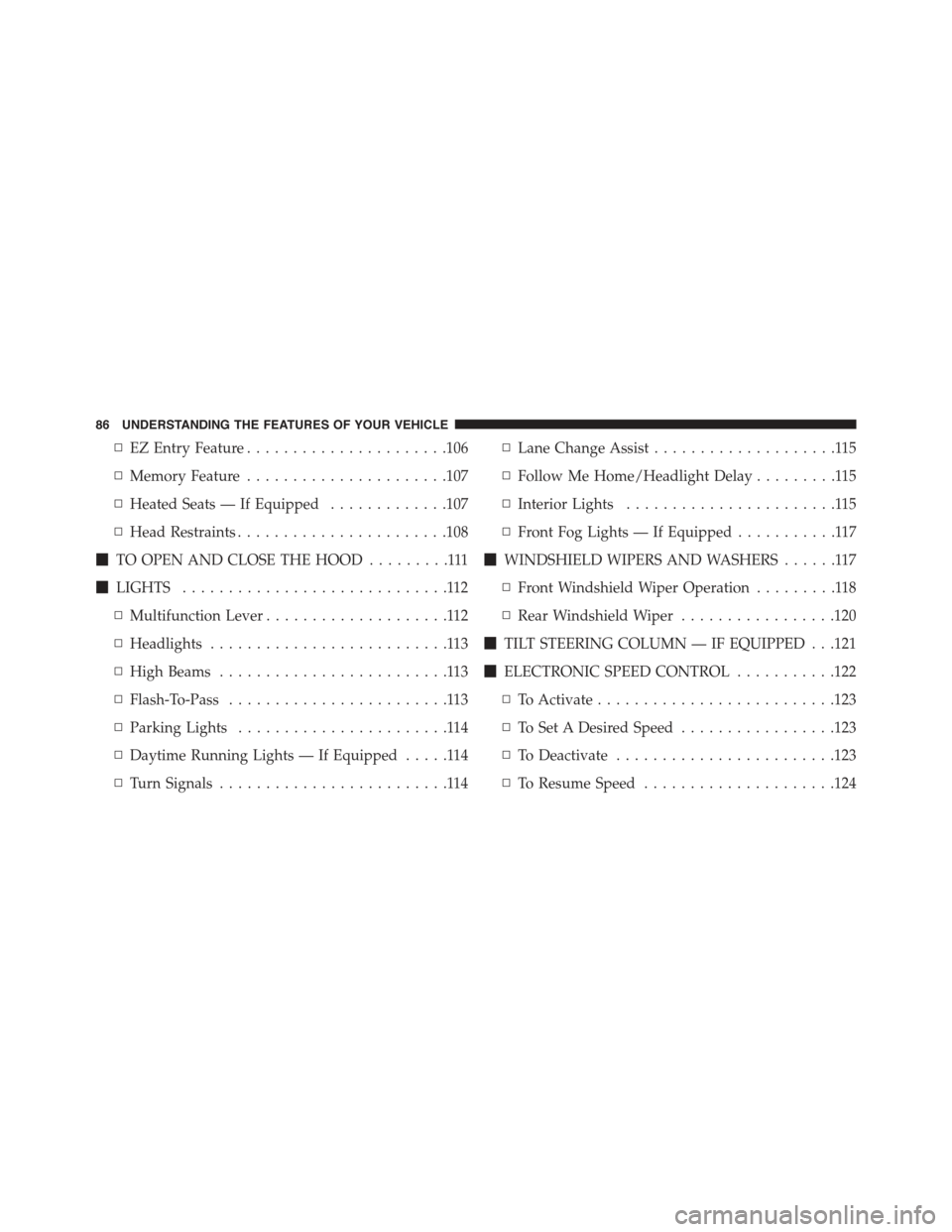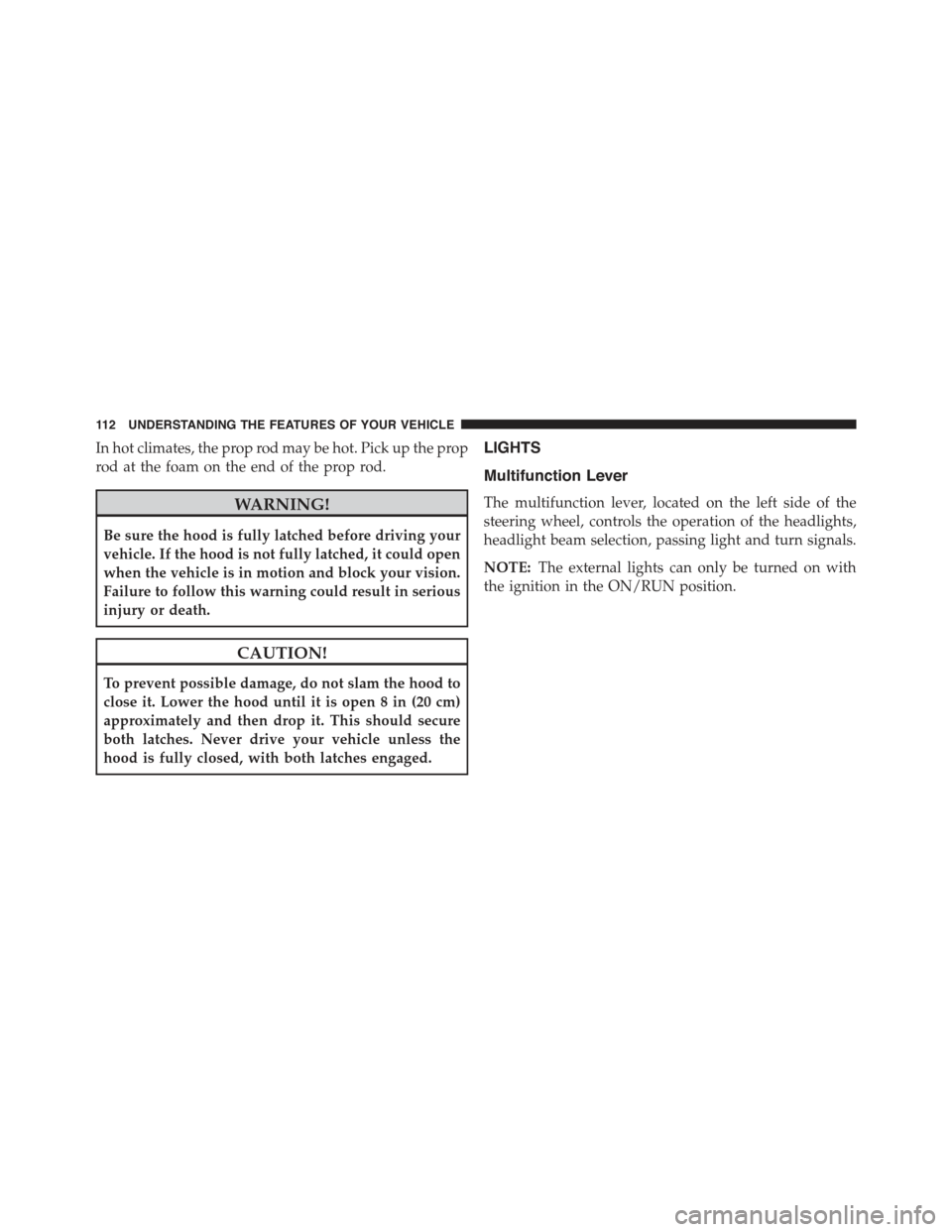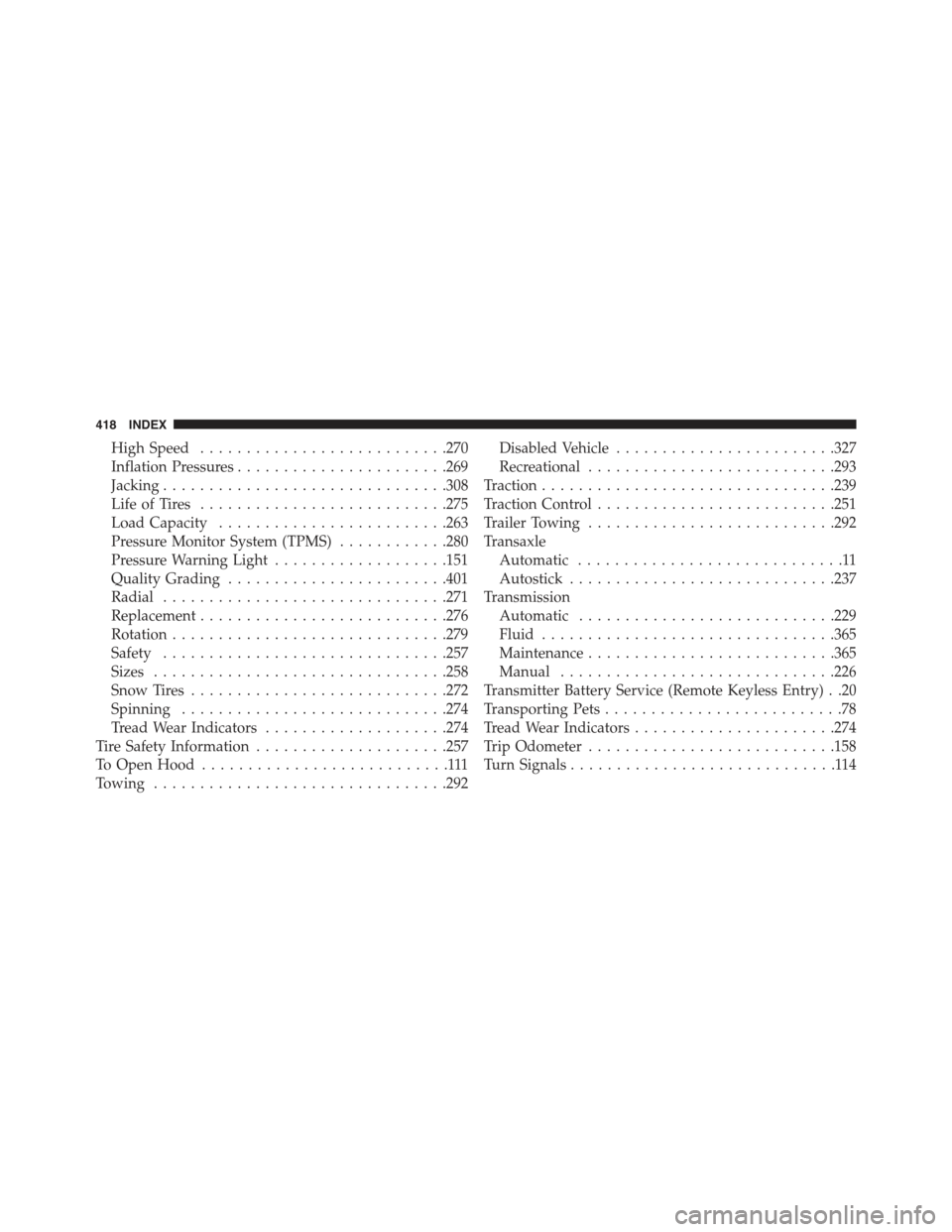open hood FIAT 500 2013 2.G Owners Manual
[x] Cancel search | Manufacturer: FIAT, Model Year: 2013, Model line: 500, Model: FIAT 500 2013 2.GPages: 423, PDF Size: 9.86 MB
Page 88 of 423

▫EZ Entry Feature......................106
▫Memory Feature......................107
▫Heated Seats — If Equipped.............107
▫Head Restraints.......................108
!TO OPEN AND CLOSE THE HOOD.........111
!LIGHTS.............................112
▫Multifunction Lever....................112
▫Headlights..........................113
▫High Beams.........................113
▫Flash-To-Pass........................113
▫Parking Lights.......................114
▫Daytime Running Lights — If Equipped.....114
▫Turn Signals.........................114
▫Lane Change Assist....................115
▫Follow Me Home/Headlight Delay.........115
▫Interior Lights.......................115
▫Front Fog Lights — If Equipped...........117
!WINDSHIELD WIPERS AND WASHERS......117
▫Front Windshield Wiper Operation.........118
▫Rear Windshield Wiper.................120
!TILT STEERING COLUMN — IF EQUIPPED . . .121
!ELECTRONIC SPEED CONTROL...........122
▫To Activate..........................123
▫To Set A Desired Speed.................123
▫To Deactivate........................123
▫To Resume Speed.....................124
86 UNDERSTANDING THE FEATURES OF YOUR VEHICLE
Page 113 of 423

TO OPEN AND CLOSE THE HOOD
To open the hood, two latches must be released.
1. Pull the bottom of the RED hood release lever, located
on the left kick panel, rearward.
2. Rotate the safety catch under the front edge of the
hood, near the center, and raise the hood.
Lift the hood prop rod that clips to the right side (left side
when standing in front of the hood) of the engine
compartment. Place the hood prop rod in the hole of
hood hinge to secure the hood in the open position.
Hood Release Lever
Hood Safety Latch Location
3
UNDERSTANDING THE FEATURES OF YOUR VEHICLE 111
Page 114 of 423

In hot climates, the prop rod may be hot. Pick up the prop
rod at the foam on the end of the prop rod.
WARNING!
Be sure the hood is fully latched before driving your
vehicle. If the hood is not fully latched, it could open
when the vehicle is in motion and block your vision.
Failure to follow this warning could result in serious
injury or death.
CAUTION!
To prevent possible damage, do not slam the hood to
close it. Lower the hood until it is open 8 in (20 cm)
approximately and then drop it. This should secure
both latches. Never drive your vehicle unless the
hood is fully closed, with both latches engaged.
LIGHTS
Multifunction Lever
The multifunction lever, located on the left side of the
steering wheel, controls the operation of the headlights,
headlight beam selection, passing light and turn signals.
NOTE:The external lights can only be turned on with
the ignition in the ON/RUN position.
11 2 U N D E R S TA N D I N G T H E F E AT U R E S O F Y O U R V E H I C L E
Page 300 of 423

CAUTION!
Driving with a hot cooling system could damage your
vehicle. If the pointer rises to the H(red) mark, the
instrument cluster will sound a chime. When safe,
pull over and stop the vehicle with the engine at idle.
Turn off the air conditioning and wait until the
pointer drops back into the normal range. If the
pointer remains on the H (red) mark for more than a
minute, turn the engine off immediately and call for
service.
WARNING!
You or others can be badly burned by hot engine
coolant (antifreeze) or steam from your radiator. If
you see or hear steam coming from under the hood,
do not open the hood until the radiator has had time
to cool. Never try to open a cooling system pressure
cap when the radiator or coolant bottle is hot.
TIREFIT KIT — IF EQUIPPED
Small punctures up to¼” (6 mm) in the tire tread can be
sealed with TIREFIT. Foreign objects (e.g., screws or
nails) should not be removed from the tire. TIREFIT can
be used in outside temperatures down to approximately
-4°F (-20°C). This kit will provide a temporary tire seal,
allowing you to drive your vehicle up to 100 miles
(160 km) with a maximum speed of 55 mph (88 km/hr).
298 WHAT TO DO IN EMERGENCIES
Page 323 of 423

WARNING!
•Take care to avoid the radiator cooling fan when-
ever the hood is raised. It can start anytime the
ignition switch is ON. You can be injured by
moving fan blades.
•Remove any metal jewelry such as rings, watch
bands and bracelets that could make an inadvertent
electrical contact. You could be seriously injured.
•Batteries contain sulfuric acid that can burn your
skin or eyes and generate hydrogen gas which is
flammable and explosive. Keep open flames or
sparks away from the battery.
1. Set the parking brake, shift the automatic transmission
into PARK and turn the ignition to LOCK.
2. Turn off the heater, radio, and all unnecessary electri-
cal accessories.
Battery Posts
1—Positive(+)Post(CoveredWithProtectiveCap)2 — Negative (-) Post
6
WHAT TO DO IN EMERGENCIES 321
Page 358 of 423

Cooling System
WARNING!
•When working near the radiator cooling fan,
disconnect the fan motor lead or turn the ignition
switch to the OFF position. The fan is temperature
controlled and can start at any time the ignition
switch is in the ON position.
•You or others can be badly burned by hot engine
coolant (antifreeze) or steam from your radiator. If
you see or hear steam coming from under the hood,
do not open the hood until the radiator has had
time to cool. Never try to open a cooling system
pressure cap when the radiator is hot.
Coolant Checks
Check engine coolant (antifreeze) protection every
12 months (before the onset of freezing weather, where
applicable). If the engine coolant (antifreeze) is dirty or
rusty in appearance, the system should be drained,
flushed and refilled with fresh engine coolant (anti-
freeze). Check the front of the A/C condenser for any
accumulation of bugs, leaves, etc. If dirty, clean by gently
spraying water from a garden hose vertically down the
face of the condenser.
Cooling System – Drain, Flush, And Refill
If the engine coolant (antifreeze) is dirty or contains
visible sediment, clean and flush with OAT coolant
(antifreeze) that meets the requirements of Chrysler
Material Standard MS-12106.
356 MAINTAINING YOUR VEHICLE
Page 420 of 423

High Speed...........................270
Inflation Pressures.......................269
Jacking...............................308
Life of Tires...........................275
Load Capacity.........................263
Pressure Monitor System (TPMS)............280
Pressure Warning Light...................151
Quality Grading........................401
Radial...............................271
Replacement...........................276
Rotation..............................279
Safety...............................257
Sizes................................258
Snow Tires............................272
Spinning.............................274
Tread Wear Indicators....................274
Tire Safety Information.....................257
To Open Hood...........................111
Towing................................292
Disabled Vehicle........................327
Recreational...........................293
Traction................................239
Traction Control..........................251
Trailer Towing...........................292
Transaxle
Automatic.............................11
Autostick.............................237
Transmission
Automatic............................229
Fluid................................365
Maintenance...........................365
Manual..............................226
Transmitter Battery Service (Remote Keyless Entry) . .20
Transporting Pets..........................78
Tread Wear Indicators......................274
Trip Odometer...........................158
Turn Signals.............................114
418 INDEX